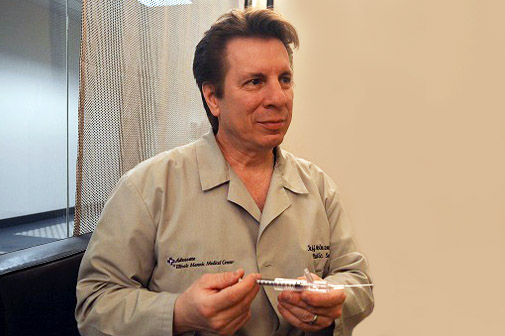Migraine treatment approach could mean lasting relief

If you’re a migraine sufferer like nearly 30 million other Americans, according to the National Headache Foundation, you probably spend a great deal of time on a constant quest for lasting relief.
Finding an alternative to prescription meds could lead to a class of procedures that get right to the source — the nerves causing the pain.
Sphenopalatine Ganglion Block could spell sweet relief
When a migraine sufferer receives a sphenopalatine ganglion block, or simply an SPG block, an anesthetic is delivered into both nostrils to the sphenopalatine ganglion. This is the largest collection of nerves in the head, located outside the brain.
The anesthetic reduces the release of norepinephrine, a hormone that tells your body to feel pain when nerves or tissue are damaged. Hence the procedure’s name—it literally blocks you from feeling the migraine by numbing the nerves that cause you to feel the pain.
The two-minute procedure reportedly can bring immediate relief, but the end goal is to reduce pain and migraine frequency over time.
Dr. Jeffrey Weinzweig, a board certified plastic surgeon and member of Advocate Physician Partners, performs this procedure. The procedure works as part of a comprehensive program he has developed to provide his patients relief.
The program requires patients to see a neurologist for an evaluation of the brain before the procedure. This evaluation may include an MRI and CT scan.
The full program then requires sessions twice weekly—a total of 12 sessions over the course of six weeks. “On the fourth, eighth and 12th sessions, we’ll do occipital nerve blocks, using a small needle inserted into two places of the scalp,” says Dr. Weinzweig. The occipital area of the scalp, where the greater and lesser occipital nerves live, is thought to be one of the main contributors to migraines.
An occipital nerve block, like the SPG block, uses an anesthetic to reduce headache pain caused by the inflamed triggering nerves. The procedure can take less than a minute, but the full effect may not be felt until two to three days later, says Dr. Weinzweig.
The time it takes for the frequency and severity of migraine pain to lessen varies for each patient. But Dr. Weinzweig says he’s had some patients report fewer and less intense migraines after three or four treatments. The need for follow-up treatments also varies for each patient.
The best part is, “No side effects. It’s like using a block that wears off,” he says. Plus, he adds, the treatment is covered by insurance.
Patients may also be seen by a physical therapist to help reduce tension in the neck, jaw, shoulders and forehead caused by migraines and other headache types.
Bye-bye headaches…and wrinkles?
The treatment methods may vary depending on the severity of the headache. Those who suffer from 15 or more headache days per month and have failed to get relief from three medications are eligible for botulinum toxin, a treatment often called by the brand name Botox.
About 11 years ago, one of Dr. Weinzweig’s plastic surgeon colleagues noticed that his patients who received botulinum toxin said their headaches were improving. That made sense: “With Botox, you’re weakening the nerve that goes to the muscle, so the muscle is no longer contracting,” explains Dr. Weinzweig. That muscle contraction can cause headaches.
So, Dr. Weinzweig explained the treatment could also successfully help migraines. When you numb the nerve, you also decrease the muscle contraction causing the migraine, he says.
The treatment requires 31 injections in the forehead, as well as on the side and back of the head. “So, best case scenario is your headache’s gone and you look better,” says Dr. Weinzweig.
How effective is SPG or any of the other nerve block methods? Dr. Weinzweig says 75 to 95 percent of his patients find relief. “After a series of blocks, one patient’s incidence of migraines decreased by 80 to 90 percent. She went from having a dozen per month to one, and the severity decreased by 50 to 60 percent,” he says.
The last resort —migraine surgery
Patients on the more severe end of the spectrum may be candidates for surgical intervention. In this case, a surgical procedure releases the nerves that trigger migraines. This is for “patients who over the course of time don’t have sufficient improvements after having gone through all the other methods,” explains Dr. Weinzweig.
Dr. Weinzweig cautions, however, that nothing works in every patient.
“There’s a cure for many problems, but there’s no panacea for migraines,” says Dr. Weinzweig. “But with a multidisciplinary approach, there is hope.”
Related Posts
Comments
One Comment
About the Author
health enews staff is a group of experienced writers from our Advocate Health Care and Aurora Health Care sites, which also includes freelance or intern writers.



















I have to thank you for the efforts you have put in penning
this site. I am hoping to check out the same high-grade blog posts by you in the future as well.
In truth, your creative writing abilities has inspired me to
get my very own blog now 😉